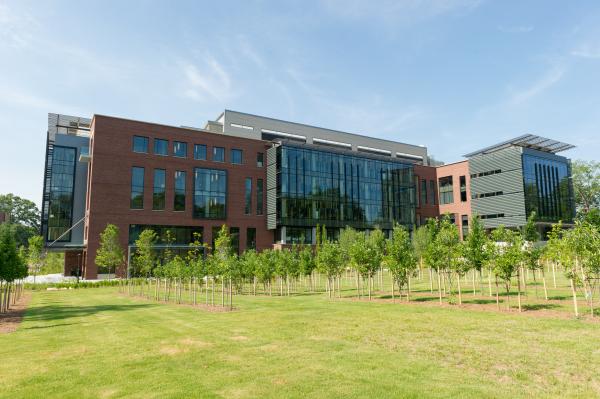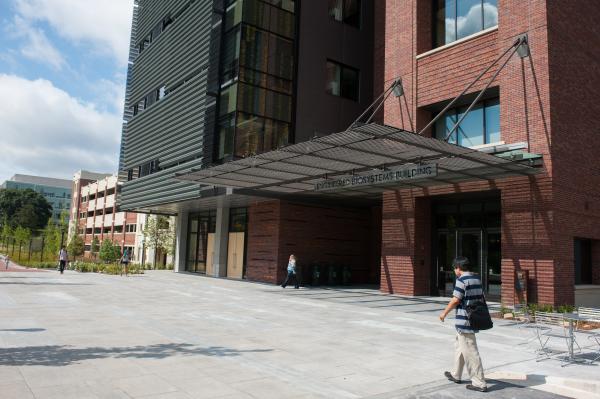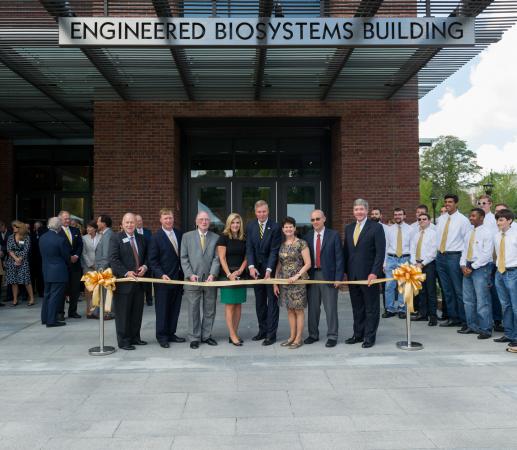In the race to save lives, researchers know that understanding and fighting diseases requires a new method of doing things.
Scientists from engineering, biology, chemistry, and computing won’t discover new vaccines and medical devices — or advance what we know about diseases — by working on their own. The next biomedical breakthroughs to provide accessible health care for billions of people worldwide will come from the collaboration between different laboratories and disciplines.
That core belief led to the creation of the Engineered Biosystems Building (EBB), the newest building at the Georgia Institute of Technology. The site opened in May and a formal dedication ceremony was held today.
EBB houses labs for research in chemical biology, cell and developmental biology, and systems biology. The building allows Georgia Tech to consolidate its biomedical research efforts in the prevention, diagnosis, and treatment of cancer, diabetes, heart disease, infections, and other life-threatening conditions.
President G.P. “Bud” Peterson said the building symbolizes what Georgia Tech is all about — collaboration and innovation.
“The EBB will drive innovation and have an undeniable impact on biomedical science and human health,” Peterson said. “EBB brings together some of the world’s finest researchers in a collaborative environment, and these collaborations will result in incredible breakthroughs.”
The building provides nearly 219,000 square feet of multidisciplinary research space and enhances the Institute’s partnerships with Emory University Hospital and with Children’s Healthcare of Atlanta.
“Together, we are changing the lives of children,” said Donna Hyland, president and CEO of Children’s Healthcare. “The space within this building helps bring our new Pediatric Technology Center to life and gives researchers another place to combine expertise in clinical care, research, and technology to solve problems that will help make kids better today and healthier tomorrow.”
The building is located on 10th Street, at the north end of the existing biotechnology complex. Other buildings in the complex include: the Parker H. Petit Institute for Bioengineering and Bioscience, the U.A. Whitaker Biomedical Engineering Building, the Ford Environmental Science and Technology Building, and the Molecular Science and Engineering Building.
More than 140 faculty and nearly 1,000 graduate students from 10 different academic units work in the labs and facilities there.
“EBB puts Georgia Tech at the forefront of biosciences and bioengineering research,” said M.G. Finn, professor and chair of the School of Chemistry and Biochemistry.
The building’s unique design allows Georgia Tech researchers to expand their work, he said.
EBB contains “research neighborhoods” designed around a specific focus or topic. These neighborhoods bring together scientists, engineers, and researchers from different disciplines around common themes or areas of interest. They share laboratories, offices, and common spaces.
Stairs alternate on various floors, encouraging people to move within the neighborhoods and throughout the building and interact with one another. Small and informal meeting areas are located near the stairwells, to further encourage researchers to talk with one another.
“We will help, influence, and support one another and bring new insights in a way that can’t happen if a building is restricted to a particular department or discipline,” Finn said.
“Ultimately we are all working to fight disease and save lives,” he said. “EBB is designed to foster the research to do just that.”
EBB is the largest building investment in Georgia Tech history. The $113 million building was made possible because of a partnership between the Institute, the Georgia Tech Foundation, and the State of Georgia, Peterson said.
State appropriations provided $64 million for the project. Georgia Tech provided $15 million in Institute funds, and private funding raised another $34 million in commitments pledged over five years.
EBB will help drive Georgia’s economy, Peterson said.
“It will foster economic development through the formation of startup enterprises, the creation of high-skilled, high-paying jobs, and the commercialization of new devices, drugs, and technologies,” Peterson said.
Media Contact
Laura Diamond
Georgia Tech Media Relations
404-894-6016
Keywords
Latest BME News
Jo honored for his impact on science and mentorship
The department rises to the top in biomedical engineering programs for undergraduate education.
Commercialization program in Coulter BME announces project teams who will receive support to get their research to market.
Courses in the Wallace H. Coulter Department of Biomedical Engineering are being reformatted to incorporate AI and machine learning so students are prepared for a data-driven biotech sector.
Influenced by her mother's journey in engineering, Sriya Surapaneni hopes to inspire other young women in the field.
Coulter BME Professor Earns Tenure, Eyes Future of Innovation in Health and Medicine
The grant will fund the development of cutting-edge technology that could detect colorectal cancer through a simple breath test
The surgical support device landed Coulter BME its 4th consecutive win for the College of Engineering competition.










